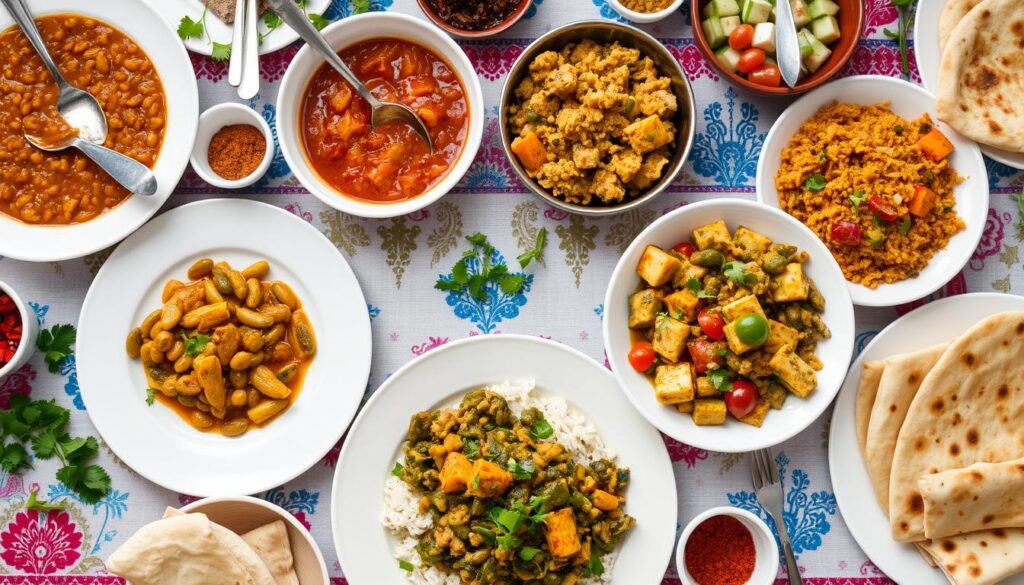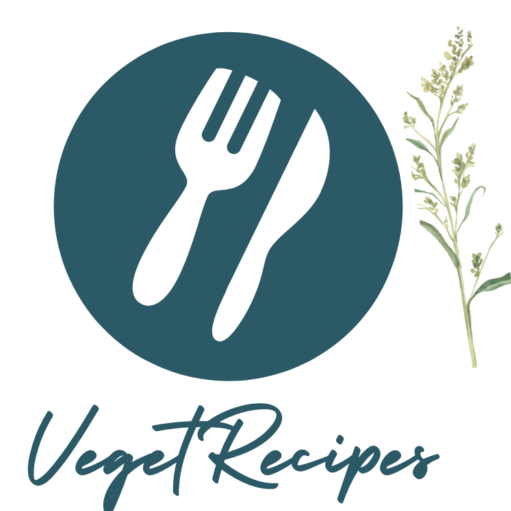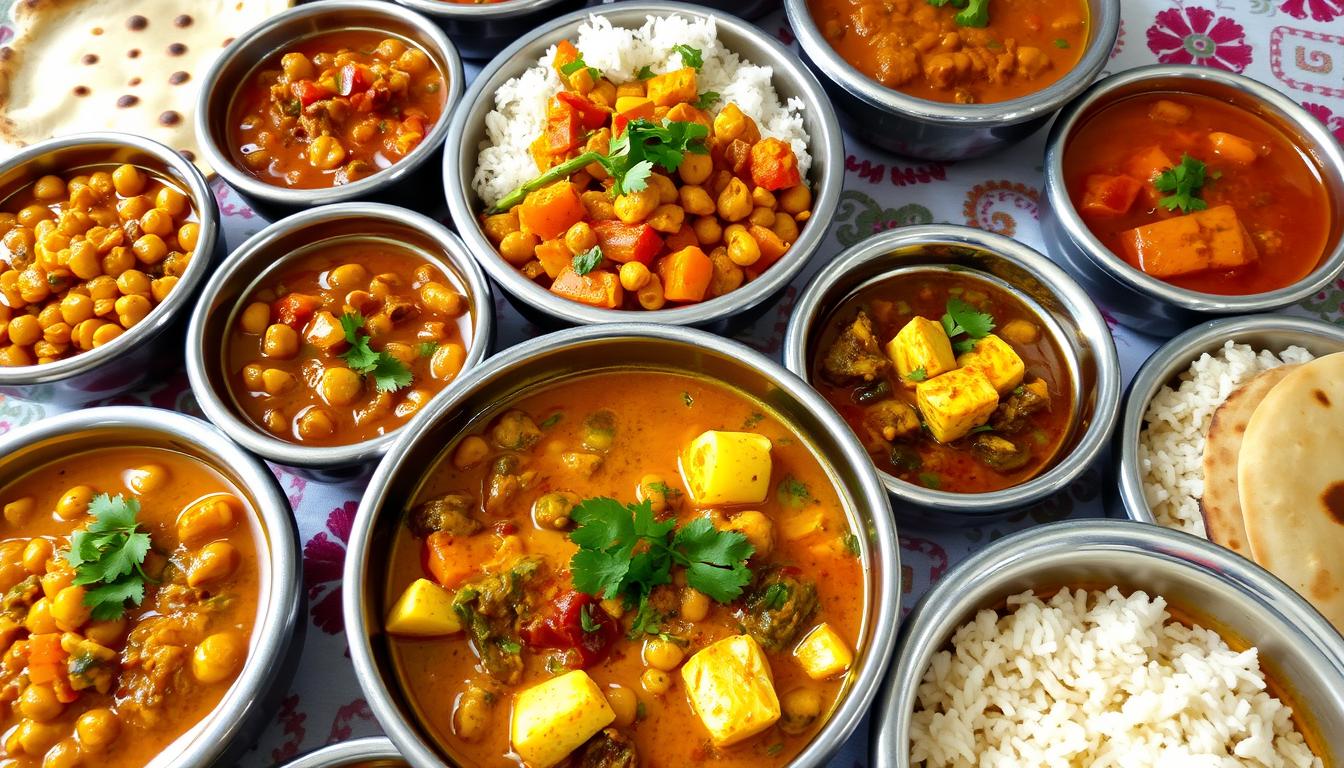Did you know that 81% of Indians limit their meat intake? About 31% of them are vegetarians. This shows how important Indian vegetarian dinner recipes are in their lives. These meals are not only tasty but also quick to make, taking about 30 minutes.
From the warm Madras Lentils to the lively Paneer Butter Masala, there’s something for everyone. Traditional Indian cuisine is full of flavors and options for every taste.
Main Points:
- 81% of Indians have some form of meat consumption restriction.
- 31% of individuals in India identify as vegetarians.
- Indian vegetarian dinner recipes can be prepared in about 30 minutes on average.
- Recipes use common spices, vegetables, and oils prevalent in Indian cooking.
- Indian cuisine offers healthy, nutritious, and flavorful meal options.
- Dishes cater to both light and heavy dinner preferences.
- Popular recipes include Paneer Butter Masala, Saag Paneer, and Malai Kofta.
Introduction to Indian Vegetarian Dinner Recipes
Indian vegetarian dinner recipes are a mix of dishes without meat. They use spices, herbs, vegetables, and grains from India. This makes them tasty and healthy. Whether you want easy dinner ideas or nutritious meals, Indian cuisine has lots to offer.
What Are Indian Vegetarian Dinner Recipes?
Indian vegetarian dinner recipes come from all over India. They include dishes like Paneer Butter Masala and Chana Masala. These meals use vegetables, legumes, and grains for a balanced diet.
The spices like cumin, coriander, and turmeric make these dishes special. They set them apart from other cuisines.
The Popularity of Indian Vegetarian Cuisine
Indian vegetarian cuisine is getting more popular worldwide. It’s loved for its taste and health benefits. People enjoy making these nutritious vegetarian meals because they’re easy to prepare.
Indian dishes can be adjusted to fit different diets. This makes them great for vegans or those on low-carb diets.
| Number of Days in Meal Plan | 7 days |
|---|---|
| Number of States Represented | 7 states (Maharashtra, Rajasthan, Gujarat, Tamil Nadu, Punjab, Uttar Pradesh, Sindh) |
| Total Meals Planned | 21 meals (7 breakfast, 7 lunch, 7 dinner) |
| Breakfast Dishes Listed | 7 different breakfast dishes |
| Lunch Dishes Listed | 7 different lunch dishes |
| Dinner Dishes Listed | 7 different dinner dishes |
| Total Variety of Dishes | 21 unique dishes |
| Total Ingredients in Shopping List | 42 distinct ingredients |
| Category Breakdown in Shopping List |
|
| Diversity in Daily Dishes | Each day features dishes from a single state, showing a unique regional cuisine. |
| Number of Vegetarian Meals | 21 meals are entirely vegetarian, catering to vegetarian dietary preferences. |
| Cooking Techniques Included | Steaming (Idli) and frying (Pakora, Dhokla), showing diverse methods used across different region recipes. |
| Cultural Highlights | Mention of specific cultural food items like “Tirmoori” (Sindhi festival food) noting unique practices related to diet. |
| Use of Specific Culinary Terms | Terms such as “Kadhi,” “Sabzi,” “Biryani” reflect regional culinary vocabularies and traditions, enriching cultural understanding. |
Benefits of Indian Vegetarian Dinner Recipes

Indian vegetarian dinner recipes are packed with health benefits. They offer a mix of flavors and nutrients, making them great for a balanced diet. Whether you’re looking for healthy plant-based dinners or quick vegetarian recipes, these meals are perfect.
Health Benefits of Indian Vegetarian Dinner Recipes
Indian vegetarian dishes are full of fiber and proteins, helping with weight loss. For example, Rajma and Vegetable Pulao has 40.5 grams of carbs, 14.3 grams of protein, and 8.9 grams of fiber. It also has 7.1 grams of fat.
Vegetable Jowar Khichdi is high in fiber, aiding digestion and weight control. Cauliflower Paratha is rich in vitamins C and K, yet low in calories.
A Flavorful and Balanced Meal Option
Indian vegetarian recipes are known for their bold flavors. They use spices and fresh ingredients, making each dish both tasty and healthy. Spinach & Moong Dal Tadka is high in fiber and low in fat, ideal for weight loss.
Palak Paneer uses low-fat paneer to keep calories down while keeping the flavor up. Baingan Bharta with tofu or low-fat paneer offers traditional tastes without the extra calories. Bajra & Whole Moong Masala Khichdi has 36.4 grams of carbs, 11.6 grams of protein, and 5.4 grams of fiber per serving.
Perfect for All Occasions
Indian vegetarian recipes are great for any time, from casual dinners to special events. Capsicum & Mushroom Stir Fry is low in fat and full of nutrients, helping with weight management. These meals use fresh vegetables and legumes, providing a variety of flavors and nutrients.
Whether it’s a hearty Rajma and Vegetable Pulao or a light Cauliflower Paratha, Indian vegetarian dinners are perfect for any meal.
Essential Ingredients for Indian Vegetarian Dinner Recipes
Making authentic Indian vegetarian dinner recipes needs careful picking of ingredients. We focus on fresh vegetables, a mix of spices, and other key items. These are vital for making tasty and flavorful veggie dishes.
Common Spices in Indian Vegetarian Cooking
Traditional Indian spices are the heart of any vegetarian dish. They add depth and richness, making the food truly special. Some common spices include:
- Turmeric
- Cumin
- Coriander
- Mustard seeds
- Garam masala
These spices mix in different ways to give Indian dishes their unique taste.
Staple Ingredients for Indian Vegetarian Dishes
Staple ingredients are the base of many Indian vegetarian meals. Items like rice, dal (lentils), and wheat are often mixed with spices and vegetables. This creates a complete and balanced dish. Here’s a quick look:
| Ingredient | Usage |
|---|---|
| Rice | Main course, side dishes |
| Dal (Lentils) | Soups, stews, curries |
| Wheat | Rotis, chapatis, naans |
These staples are easy to find and keep for a long time. They’re a key part of making flavorful veggie dishes.
Fresh Vegetables for Authentic Recipes
Fresh vegetables are key in making real Indian vegetarian recipes. They add color, texture, and nutrition to the dishes. Common vegetables include:
- Spinach
- Potatoes
- Cauliflower
- Tomatoes
- Peas
Using these vegetables in your cooking makes meals healthy and tasty. It captures the true spirit of traditional Indian spices.
Step-by-Step Guide to Preparing Indian Vegetarian Dinner Recipes
Making a tasty Indian vegetarian dinner needs careful planning. You must prepare fresh ingredients and learn traditional cooking methods. It’s also important to balance flavors. This guide will help you make delicious homemade vegetarian curries that everyone will love.
Planning Your Indian Dinner Menu
When planning your Indian vegetarian menu, mix and match is key. Make sure to include proteins, carbs, and veggies. Try making Vegetable Biryani, Dal Makhani, and Paneer Butter Masala. Each dish brings its own unique taste and texture.
Preparing Ingredients for Indian Recipes
Getting your ingredients right is essential for authentic Indian dishes. Use carrots, peas, green beans, potatoes, cauliflower, and sometimes sweet corn. Spice blending is also critical. Here’s what you need for a Vegetable Curry:
| Vegetables | Quantity |
|---|---|
| Carrots | ¾ to 1 cup |
| Peas | ½ to ¾ cup |
| Green beans | ½ cup |
| Potatoes | ¾ to 1 cup |
| Cauliflower | 1½ cups florets |
| Sweet corn (optional) | ¼ cup |
Cooking Techniques in Indian Vegetarian Cuisine
Indian cooking uses many methods, but sautéing, frying, and simmering are key for vegetarian curries. These techniques bring out the best in ingredients and spices, creating a rich, aromatic dish.
- Sautéing (Bhuna): Cooks onion-tomato masala until fragrant, about 1 minute.
- Frying (Tadka): Tempering spices to release their oils and flavors, using 2 to 3 tablespoons of oil.
- Simmering (Dum): Cooks dishes like Vegetable Biryani slowly for the best flavor.
Balancing Flavors in Indian Dishes
The secret to Indian dishes is the harmony of spices. A curry might include Kashmiri red chili powder, coriander powder, cumin powder, turmeric, and Garam Masala. Getting the spice balance right makes your vegetarian curries taste amazing.
- Kashmiri red chili powder: Adds color and gentle heat, needed about ¾ to 1¼ teaspoon.
- Coriander powder: Essential for earthy flavors, usually 1 to 1½ teaspoon.
- Cumin powder: Adds warmth and nutty taste, typically 1 teaspoon.
- Garam Masala: A complex blend used towards the end, about 1 teaspoon or 1½ tablespoons of mild Curry Powder.
By following these steps, you’ll master Indian vegetarian cooking. Your meals will be a flavorful success every time.
Delicious Indian Vegetarian Dinner Recipes
Indian cuisine has many tasty vegetarian dinner recipes. These dishes are full of flavor and variety. We’ll look at four great ones: Paneer Butter Masala with Naan, Vegetable Biryani, Dal Tadka and Jeera Rice, and Chana Masala with Chapati. They are loved by many and show off the best of spices, textures, and cooking methods.
Paneer Butter Masala with Naan
Paneer Butter Masala is a classic dish. It has chunks of paneer (Indian cottage cheese) in a creamy tomato gravy. The mix of tangy tomatoes, rich butter, and cream makes it very satisfying. Serving it with naan, a type of Indian bread, adds to the enjoyment.
Vegetable Biryani
Vegetable Biryani is known for its aromatic rice and spiced vegetables. This layered rice dish is flavored with saffron and garam masala. It’s cooked under a tight lid to soak up all the flavors. It’s a great one-pot meal for any time, full of taste and nutrition.
Dal Tadka and Jeera Rice
Dal Tadka is a comforting dish. It has yellow lentils cooked with ghee, cumin seeds, garlic, and red chili. Paired with jeera rice, it makes a warm and filling meal. It’s a favorite in many homes for its simplicity and hearty taste.
Chana Masala with Chapati
Chana Masala is a popular chickpea curry. It’s made with tomatoes, onions, and spices. It’s often served with chapati, a soft whole wheat bread. The spicy curry and soft chapati make for a wonderful meal.
| Dish | Description | Best Accompaniment |
|---|---|---|
| Paneer Butter Masala | Paneer cubes in a rich, creamy tomato gravy | Naan |
| Vegetable Biryani | Aromatic rice with spiced vegetables | Raita or Shorba |
| Dal Tadka | Tempered yellow lentils | Jeera Rice |
| Chana Masala | Spiced chickpea curry | Chapati |
Serving Indian Vegetarian Dinner Recipes
Indian vegetarian dinners can be made more exciting with vibrant textures and colors. A well-thought-out presentation can greatly enhance the dining experience.
Creative Plating Ideas for Indian Dinners
Indian cuisine is full of vibrant ingredients and flavors. To impress, use garnishes like pomegranate seeds, fresh cilantro, and lemon wedges. Traditional tableware, like copper or brass, adds authenticity. Arrange dishes in patterns that show off the variety of textures and components.
Pairing Drinks with Indian Vegetarian Recipes
The right drink can boost your meal’s flavors. Try lassi or spiced tea (chai) for a traditional touch. Infused water with mint, lemon, and cucumber also offers a refreshing contrast.
| Meal Type | Drink Pairing |
|---|---|
| Dinner | Salted Lassi |
| Spicy Curry | Mango Lassi |
| Light Meal | Mint Tea |
| Heavy Meal | Buttermilk |
Side Dishes to Complement Indian Meals
Adding side dishes can make your vegetarian dinner complete. Here are some favorites:
- Raita: A cool yogurt dish that soothes spicy flavors.
- Pickles: They add a tangy and spicy touch.
- Papad: Crispy wafers that contrast nicely in texture.
These sides add depth and balance to your meal. They make dining more enjoyable. Using these tips will make your meals both tasty and visually appealing.
Tips for Perfect Indian Vegetarian Dinner Recipes
Indian vegetarian meals are an art that mixes spices, fresh ingredients, and old techniques. With the right steps, you can make dishes that taste great and fit many diets.
Achieving the Right Spice Level
Finding the perfect spice mix is a big challenge in Indian vegetarian cooking. Here are some spice adjustment tips to get the flavor right:
- Start with a small amount of spices and add more as needed.
- Think about the spice tolerance of your guests and adjust.
- Blend whole and ground spices for a richer taste.
Remember, making a classic Indian vegetarian dish like Potato Curry takes about 30 minutes. This allows for fine-tuning the spice levels as you cook.
Making Dishes Suitable for All Diets
Indian vegetarian food is very flexible, making it easy to fit different diets. Many dishes, like Aloo Gobi, are naturally gluten-free, which suits about 20% of people who avoid gluten.
About 30% of Indian vegetarians prefer vegan options, showing the demand for vegan recipes like Curries with Lentils and Coconut Milk. Here’s how to make your dishes inclusive:
- Replace dairy with plant-based options like coconut milk or almond yogurt.
- Choose gluten-free flours or grains when needed.
- Add plant-based proteins like chickpeas, which have about 15 grams of protein per cup.
Preparing Meals Ahead for Convenience
Being efficient in the kitchen means preparing parts of your meal early. This cuts down cooking time and stress:
- Make masalas and chop veggies ahead of time.
- Use one-pot cooking, which 55% of cooks prefer for ease.
- Plan meals that can be made in under 30 minutes, for the 46% of households with busy schedules.
By learning these prep methods, making Indian vegetarian meals becomes easy and fun.
Storing and Reheating Indian Vegetarian Dinner Recipes
Keeping the flavors and textures of Indian vegetarian dishes fresh is important. There are many meals to choose from. Storing leftovers correctly can make meal prep easier. Knowing how to reheat your meals right can also keep their taste fresh, even later.
How to Store Leftover Indian Dishes
Leftovers need to be in airtight containers to keep moisture in and out. Curries and rice can stay good in the fridge for 3-4 days. Freezing is a good option for longer storage.
| Recipe | Refrigerator Shelf Life | Freezer Shelf Life |
|---|---|---|
| Make-Ahead Spinach Manicotti | 3 days | 6 months |
| Five-Cheese Ziti al Forno | 4 days | 6 months |
| Black Bean Dal | 3 days | 6 months |
| Aloo Methi Paratha | 2 days | 3 months |
Reheating Without Losing Flavor
It’s important to use gentle heat when reheating. Stovetop or microwave on low to medium power works best. For rice, add a bit of water before microwaving to keep it moist.
Freezing Indian Curries and Rice Dishes
Freezing is great for food preservation and meal planning. Curries like Shahi Dal and subzis freeze well. Semi-cooked rotis and parathas also freeze well for quick reheating.
For effective reheating tips, thaw frozen items in the fridge overnight. Then, reheat gently to keep the meal delicious.
Conclusion: Mastering the Art of Indian Vegetarian Dinner Recipes
Learning to cook Indian dishes is a journey filled with exciting flavors and aromas. It starts with knowing key spices like cumin, coriander, turmeric, and garam masala. These spices add flavor and health benefits to vegetarian dishes.
When cooking for your family, remember the importance of tadka (tempering) and sautéing onions. These steps are key to making curries rich in flavor. Adding sweetness to spicy dishes is also common, balancing out the heat. Using fresh spices, ground just before use, enhances flavors in most Indian dishes.
It’s important to balance creamy sauces with lighter, coconut-based dishes. This shows the variety of North and South Indian cooking. Cooking authentic dishes takes time, from 1 to 2 hours. Mastering Indian cooking means you can serve meals that are both delicious and satisfying. Start your journey with Indian vegetarian recipes and enjoy the flavors.

